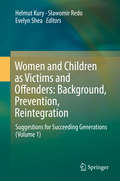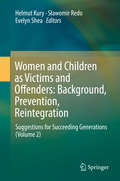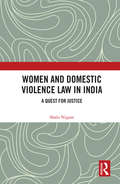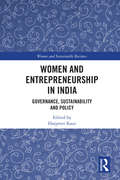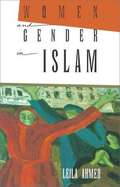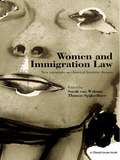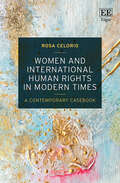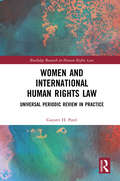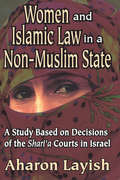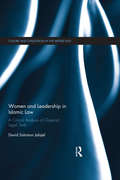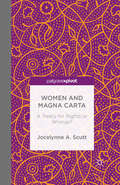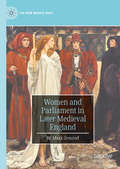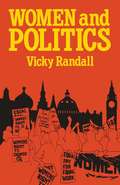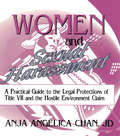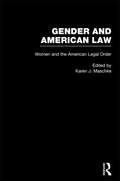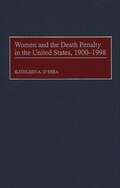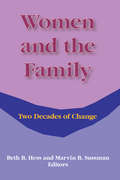- Table View
- List View
Women and Children as Victims and Offenders: Suggestions for Succeeding Generations (Volume 1)
by Helmut Kury Sławomir Redo Evelyn SheaThis work compiles experiences and lessons learned in meeting the unique needs of women and children regarding crime prevention and criminal justice, in particular the treatment and social reintegration of offenders, and serves a as a cross-disciplinary work for academic and policy-making analyses and follow-up in developing and developed countries.Furthermore, it argues for a more humane and effective approach to countering delinquency and crime among future generations. In a world where development positively depends on the rule of law and the related investment security, two global trends may chart the course of development: urbanization and education. Urbanization will globalize the concepts of “justice” and “fairness”; education will be dominated by the urban mindset and digital service economy, just as a culture of lawfulness will. This work looks at crime prevention education as an investment in the sustainable quality of life of succeeding generations, and at those who pursue such crime prevention as the providers of much-needed skills in the educational portfolio. Adopting a reformist approach, this work collects articles with findings and recommendations that may be relevant to domestic and international policymaking, including the United Nations Studies and their educational value for the welfare of coming generations. The books address the relevant United Nations ideas by combining them with academic approaches. Guided by the Editors’ respective fields of expertise, and in full recognition of academic freedom and “organized scepticism”, it includes contributions by lawyers, criminologists, sociologists and other eminent experts seeking to bridge the gap between academic and policy perspectives, as appropriate, against the international background, including the United Nations developments. The first volume opens with a foreword by Marta Santos Pais, the United Nations Special Representative of the Secretary-General on Violence against Children, and a general introduction by the editors. Part I provides an overview of United Nations principles for crime prevention and the treatment of women and children. Part II concentrates on education and the social learning of children and adolescents. The importance of quality education is stressed as is its impact on the behaviour of children of all ages. It also includes a discussion of the factors that still hinder access to good schooling in many parts of the world. Part III presents international research findings on children, juveniles and women both as victims and offenders. Statistics show overwhelmingly that these groups are more often victims than offenders.
Women and Children as Victims and Offenders: Suggestions for Succeeding Generations (Volume 2)
by Helmut Kury Sławomir Redo Evelyn SheaThis work compiles experiences and lessons learned in meeting the unique needs of women and children regarding crime prevention and criminal justice, in particular the treatment and social reintegration of offenders and serves as a cross-disciplinary work for academic and policy-making analyses and follow-up in developing and developed countries.Furthermore, it argues for a more humane and effective approach to countering delinquency and crime among future generations. In a world where development positively depends on the rule of law and the related investment security, two global trends may chart the course of development: urbanization and education. Urbanization will globalize the concepts of “justice” and “fairness”; education will be dominated by the urban mindset and digital service economy, just as a culture of lawfulness will. This work looks at crime prevention education as an investment in the sustainable quality of life of succeeding generations, and at those who pursue such crime prevention as the providers of much-needed skills in the educational portfolio. Adopting a reformist approach, this work collects articles with findings and recommendations that may be relevant to domestic and international policymaking, including the United Nations Studies and their educational value for the welfare of coming generations. The books address the relevant United Nations ideas by combining them with academic approaches. Guided by the Editors’ respective fields of expertise, and in full recognition of academic freedom and “organized scepticism”, it includes contributions by lawyers, criminologists, sociologists and other eminent experts seeking to bridge the gap between academic and policy perspectives, as appropriate, against the international background, including the United Nations developments.The second volume opens with Part IV, which presents articles on different kinds of crime prevention. The effectiveness of punishment and, in particular, imprisonment is examined by contrasting it with alternative sanctions and the following questions are raised: Does harsh punishment have a crime preventive effect? What are the side effects of imprisonment on the offenders and their families? Are alternatives, such as restorative justice or mediation, more effective and cheaper? Part V outlines proactive strategies of crime prevention, e.g. for potential sex offenders or in the domain of internet crime. Part VI envisions a more peaceful and inclusive society, which would be realized by improving the protection of women and children in their everyday life, and easing the reintegration of those who have become offenders. The importance of the role played by the UN in formulating these goals is underlined. The volume concludes with an epilogue of the 70th President of the United Nations Economic and Social Council, Martin Sajdik, and a post scriptum of the editors. p>
Women and Domestic Violence Law in India: A Quest for Justice
by Shalu NigamThis book critically examines domestic violence law in India. It focuses on women’s experiences and perspectives as victims and litigants, with regard to accessibility to law and justice. It also reflects on the manner in which the legal process reproduces gender hierarchies. This volume: Analyzes the legal framework from a gender perspective to pinpoint the inherent stereotypes, prejudices and discriminatory practices that come into play while interpreting the law; Includes in-depth interviews and case studies, and explores critical themes such as marriage, rights, family, violence, property and the state; Presents alternatives beyond the domain of law, such as qualitative medical care and legal aid facilities, shelter homes, short-stay homes, childcare facilities, and economic and social security provisions to survivors and their children. Drawing on extensive testimonies and ethnographic studies situated in a theoretical framework of law, this book will be of great interest to scholars and researchers of law, gender, human rights, women’s studies, sociology and social anthropology, and South Asian studies.
Women and Domestic Violence Law in India: A Quest for Justice
by Shalu NigamThis book critically examines domestic violence law in India. It focuses on women’s experiences and perspectives as victims and litigants, with regard to accessibility to law and justice. It also reflects on the manner in which the legal process reproduces gender hierarchies. This volume: Analyzes the legal framework from a gender perspective to pinpoint the inherent stereotypes, prejudices and discriminatory practices that come into play while interpreting the law; Includes in-depth interviews and case studies, and explores critical themes such as marriage, rights, family, violence, property and the state; Presents alternatives beyond the domain of law, such as qualitative medical care and legal aid facilities, shelter homes, short-stay homes, childcare facilities, and economic and social security provisions to survivors and their children. Drawing on extensive testimonies and ethnographic studies situated in a theoretical framework of law, this book will be of great interest to scholars and researchers of law, gender, human rights, women’s studies, sociology and social anthropology, and South Asian studies.
Women and Entrepreneurship in India: Governance, Sustainability and Policy (Women and Sustainable Business)
by Harpreet KaurThe Indian Constitution is the largest written constitution that guarantees equality to women and empowers the State to take affirmative actions in favour of women. India has adopted International conventions for protection of rights of women and granting them equality and ratified the Convention on Elimination of All Forms of Discrimination Against Women (CEDAW) in the year 1993. The National Policy for Women Empowerment was presented in 2001, the goal of that policy to bring about the advancement, development and empowerment of women and enable women to become financially independent. Currently, India is the only country where the economic gender gap is larger than the political gender gap. Women are required to understand their own potential and overcome social barriers. With constant support of the government, change in stereotype mindset and skill development in women, India will continue witnessing gradual increase in women entrepreneurship in future. The aim of this book is to show the latest state of knowledge on the topic of women entrepreneurship, the role of women in business and women empowerment in India. Many aspects relating to role of women in business, sustainable business development and aspects going beyond economic empowerment of women are discussed in addition to presenting legal and regulatory frameworks. This book will be of interest to researchers, academics, policymakers, and students in the fields of entrepreneurship, empowerment, gender studies, and law.
Women and Entrepreneurship in India: Governance, Sustainability and Policy (Women and Sustainable Business)
by Harpreet KaurThe Indian Constitution is the largest written constitution that guarantees equality to women and empowers the State to take affirmative actions in favour of women. India has adopted International conventions for protection of rights of women and granting them equality and ratified the Convention on Elimination of All Forms of Discrimination Against Women (CEDAW) in the year 1993. The National Policy for Women Empowerment was presented in 2001, the goal of that policy to bring about the advancement, development and empowerment of women and enable women to become financially independent. Currently, India is the only country where the economic gender gap is larger than the political gender gap. Women are required to understand their own potential and overcome social barriers. With constant support of the government, change in stereotype mindset and skill development in women, India will continue witnessing gradual increase in women entrepreneurship in future. The aim of this book is to show the latest state of knowledge on the topic of women entrepreneurship, the role of women in business and women empowerment in India. Many aspects relating to role of women in business, sustainable business development and aspects going beyond economic empowerment of women are discussed in addition to presenting legal and regulatory frameworks. This book will be of interest to researchers, academics, policymakers, and students in the fields of entrepreneurship, empowerment, gender studies, and law.
Women and Gender in Islam: Historical Roots of a Modern Debate (PDF)
by Leila AhmedAre Islamic societies inherently oppressive to women? Is the trend among Islamic women to appear once again in veils and other traditional clothing a symbol of regression or an effort to return to a "pure" Islam that was just and fair to both sexes? In this book Leila Ahmed adds a new perspective to the current debate about women and Islam by exploring its historical roots, tracing the developments in Islamic discourses on women and gender from the ancient world to the present. In order to distinguish what was distinctive about the earliest Islamic doctrine on women, Ahmed first describes the gender systems in place in the Middle East before the rise of Islam. She then focuses on those Arab societies that played a key role in elaborating the dominant Islamic discourses about women and gender: Arabia during the period in which Islam was founded; Iraq during the classical age, when the prescriptive core of legal and religious discourse on women was formulated; and Egypt during the nineteenth and twentieth centuries, when exposure to Western societies led to dramatic social change and to the emergence of new discourses on women. Throughout, Ahmed not only considers the Islamic texts in which central ideologies about women and gender developed or were debated but also places this discourse in its social and historical context. Her book is thus a fascinating survey of Islamic debates and ideologies about women and the historical circumstances of their position in society, the first such discussion using the analytic tools of contemporary gender studies.
Women and Immigration Law: New Variations on Classical Feminist Themes
by Sarah Van Walsum Thomas SpijkerboerThis book examines immigration law from a gender perspective. It shows how immigration law situates gender conflicts outside the national order, projecting them onto non-western countries, exotic cultures, clandestine labour and criminal organizations. In doing so, immigration law sustains the illusion that gender conflicts have moved beyond the pale of European experience. In fact, the classical feminist themes of patriarchy, the gendered division of labour and sexual violence are still being played out at the heart of Europe's societies, involving both citizens and migrants. This collection of essays demonstrates how the seemingly marginal perspective of immigration law highlights Europe's unresolved gender conflicts and how a gender perspective can help us to rethink immigration law.
Women and Immigration Law: New Variations on Classical Feminist Themes
This book examines immigration law from a gender perspective. It shows how immigration law situates gender conflicts outside the national order, projecting them onto non-western countries, exotic cultures, clandestine labour and criminal organizations. In doing so, immigration law sustains the illusion that gender conflicts have moved beyond the pale of European experience. In fact, the classical feminist themes of patriarchy, the gendered division of labour and sexual violence are still being played out at the heart of Europe's societies, involving both citizens and migrants. This collection of essays demonstrates how the seemingly marginal perspective of immigration law highlights Europe's unresolved gender conflicts and how a gender perspective can help us to rethink immigration law.
Women and International Human Rights in Modern Times: A Contemporary Casebook
by Rosa CelorioThis casebook provides an overview of the main international and regional legal standards related to the human rights of women and explores their development and practical application in light of contemporary times, challenges, and advances. It navigates the nuances of the ongoing problems of discrimination and gender-based violence, and analyzes them in the context of modern challenges, such as the COVID-19 pandemic, the MeToo movement and its aftermath, the growth of non-state actors, environment and climate change, sexual orientation and gender identity, and the digital world, among others.Incorporating lessons learned from her experiences as a practitioner and a law professor, the author navigates and provides snapshots of priority issues and themes in the field of the human rights of women. In each chapter, students are encouraged to reflect and answer questions alluding to the intricacies, challenges, and advances in the protection and exercise of women’s rights in modern times. The chapters also include many case judgments, decisions, views, and general recommendations adopted by universal and regional bodies and courts advancing the development of women human rights issues. This analysis is complemented by key scholarship, reports, and statements produced in the area of the human rights of women and its different features.Students of issues concerning human rights, women, gender equality, and international law will attain a thorough understanding of the field through this contemporary casebook.
Women and International Human Rights Law: Universal Periodic Review in Practice (Routledge Research in Human Rights Law)
by Gayatri H. PatelThis book presents the findings of the first comprehensive study on the most recent and most unique and innovative method of monitoring international human rights law at the United Nations. Since its existence, there has yet to be a complete and comprehensive book solely dedicated to exploring the Universal Periodic Review (UPR) process. Women and International Human Rights Law provides a much-needed insight to what the process is, how it operates in practice, and whether it meets its fundamental aim of promoting the universality of all human rights. The book addresses the topics with regard to international human rights law and will be of interest to researchers, academics, and students interested in the monitoring and implementation of international human rights law at the United Nations. In addition, it will form supplementary reading for those students studying international human rights law on undergraduate programmes and will also appeal to academics and students with interests in political sciences and international relations.
Women and International Human Rights Law: Universal Periodic Review in Practice (Routledge Research in Human Rights Law)
by Gayatri H. PatelThis book presents the findings of the first comprehensive study on the most recent and most unique and innovative method of monitoring international human rights law at the United Nations. Since its existence, there has yet to be a complete and comprehensive book solely dedicated to exploring the Universal Periodic Review (UPR) process. Women and International Human Rights Law provides a much-needed insight to what the process is, how it operates in practice, and whether it meets its fundamental aim of promoting the universality of all human rights. The book addresses the topics with regard to international human rights law and will be of interest to researchers, academics, and students interested in the monitoring and implementation of international human rights law at the United Nations. In addition, it will form supplementary reading for those students studying international human rights law on undergraduate programmes and will also appeal to academics and students with interests in political sciences and international relations.
Women and Islamic Law in a Non-Muslim State: A Study Based on Decisions of the Shari'a Courts in Israel
by Ahron LayishThis book is methodologically unique in scholarly literature on Muslim society. Its originality lies in the fact that the rich material offered by the shari'a courts is given a thorough analysis with a view to drawing conclusions about the present-day phenomena in Arab society and processes that the society has been undergoing in modern times.Aharon Layish examines every aspect of the social status of Muslim women that finds expression in the shari'a courts: the age of marriage, stipulations inserted in the marriage contract, dower, polygamy, maintenance and obedience, divorce, custody of the children, guardianship, and succession. Each chapter opens with a short legal introduction based on all the sources of law applying in shari'a courts, followed by social analyses and a study of the attitudes and approaches of the qadis, or Muslim religious judges. Layish examines the relationship between shari'a and Israeli legislation: Do shari'a courts have regard to the provisions of Israeli law? What is the relationship between shari'a and social custom, and which is decisive in regard to Israeli Muslim women? To what extent does Israeli law actually affect Israeli Muslim women? What is the attitude of the qadis, toward Israeli legislation?Women and Islamic Law in a Non-Muslim State is an important and original study that will be of interest to students and scholars of Islamic law, comparative law, sociology, and modernization.
Women and Islamic Law in a Non-Muslim State: A Study Based on Decisions of the Shari'a Courts in Israel
by Ahron LayishThis book is methodologically unique in scholarly literature on Muslim society. Its originality lies in the fact that the rich material offered by the shari'a courts is given a thorough analysis with a view to drawing conclusions about the present-day phenomena in Arab society and processes that the society has been undergoing in modern times.Aharon Layish examines every aspect of the social status of Muslim women that finds expression in the shari'a courts: the age of marriage, stipulations inserted in the marriage contract, dower, polygamy, maintenance and obedience, divorce, custody of the children, guardianship, and succession. Each chapter opens with a short legal introduction based on all the sources of law applying in shari'a courts, followed by social analyses and a study of the attitudes and approaches of the qadis, or Muslim religious judges. Layish examines the relationship between shari'a and Israeli legislation: Do shari'a courts have regard to the provisions of Israeli law? What is the relationship between shari'a and social custom, and which is decisive in regard to Israeli Muslim women? To what extent does Israeli law actually affect Israeli Muslim women? What is the attitude of the qadis, toward Israeli legislation?Women and Islamic Law in a Non-Muslim State is an important and original study that will be of interest to students and scholars of Islamic law, comparative law, sociology, and modernization.
Women and Leadership in Islamic Law: A Critical Analysis of Classical Legal Texts (Culture and Civilization in the Middle East)
by David Solomon JalajelIslamic law has traditionally prohibited women from being prayer leaders and heads of state. A small number of Muslims today are beginning to challenge this stance, but they face considerable opposition from the broader Muslim community. ‘Women and Leadership in Islamic Law’ examines the assumption within much existing feminist scholarship that the patriarchal nature of pre-Islamic and early Muslim Near Eastern Society is the primary reason for the development of Islamic legal rulings prohibiting women from leadership positions. It claims that the evolution of Islamic law was a complex process, shaped by numerous cultural, historical, political and social factors, as well as scriptural sources whose importance cannot be dismissed. Therefore, the book critically examines a broad survey of legal works from the four canonical Sunni schools of law to determine the factors that influenced the development of the legal rulings prohibiting women from assuming various leadership roles. The passages that elaborate rulings about women’s leadership are presented in translation as an appendix to the research, and are then subjected to a variety of critical analyses to identify the reasons, influences, and assumptions underlying those rulings. This is the first time works of all four schools of law have been subjected to this kind of analysis for the express purpose of determining the extent to which gender attitudes have influenced and determined the rulings. This book will therefore be a vital resource for students and scholars of Islamic Studies, Religious Studies and Gender Studies.
Women and Leadership in Islamic Law: A Critical Analysis of Classical Legal Texts (Culture and Civilization in the Middle East)
by David Solomon JalajelIslamic law has traditionally prohibited women from being prayer leaders and heads of state. A small number of Muslims today are beginning to challenge this stance, but they face considerable opposition from the broader Muslim community. ‘Women and Leadership in Islamic Law’ examines the assumption within much existing feminist scholarship that the patriarchal nature of pre-Islamic and early Muslim Near Eastern Society is the primary reason for the development of Islamic legal rulings prohibiting women from leadership positions. It claims that the evolution of Islamic law was a complex process, shaped by numerous cultural, historical, political and social factors, as well as scriptural sources whose importance cannot be dismissed. Therefore, the book critically examines a broad survey of legal works from the four canonical Sunni schools of law to determine the factors that influenced the development of the legal rulings prohibiting women from assuming various leadership roles. The passages that elaborate rulings about women’s leadership are presented in translation as an appendix to the research, and are then subjected to a variety of critical analyses to identify the reasons, influences, and assumptions underlying those rulings. This is the first time works of all four schools of law have been subjected to this kind of analysis for the express purpose of determining the extent to which gender attitudes have influenced and determined the rulings. This book will therefore be a vital resource for students and scholars of Islamic Studies, Religious Studies and Gender Studies.
Women and The Magna Carta: A Treaty for Control or Freedom?
by Jocelynne ScuttOn the eight-hundredth anniversary of the Magna Carta, Women and the Magna Carta investigates what the charter meant for women's rights and freedoms from an historical and legal perspective.
Women and Parliament in Later Medieval England (The New Middle Ages)
by W. Mark OrmrodThis Palgrave Pivot provides the first ever comprehensive consideration of the part played by women in the workings and business of the English Parliament in the later Middle Ages. Breaking new ground, this book considers all aspects of women’s access to the highest court of medieval England. Women were active supplicants to the Crown in Parliament, and sometimes appeared there in person to prosecute cases or make political demands. It explores the positions of women of varying rank, from queens to peasants, vis-à-vis this male institution, where they very occasionally appeared in person but were more usually represented by written petitions. A full analysis of these petitions and of the official records of parliament reveals that there were a number of issues on which women consistently pressed for changes in the law and its administration, and where the Commons and the Crown either championed or refused to support reform. Such is the concentration of petitions on the subjects of dower and rape that these may justifiably be termed ‘women’s issues’ in the medieval Parliament.
Women and Sexual Harassment: A Practical Guide to the Legal Protections of Title VII and the Hostile Environment Claim
by Robert C Berring Anja A ChanHere is a valuable guide that saves researchers investigating sexual harassment in the workplace enormous amounts of time and money. Focusing on the hostile environment claim under Title VII of the Civil Rights Act of 1964, Women and Sexual Harassment is a complete resource tool. In one easy-to-use volume, it provides a detailed background and history of the hostile environment claim as well as an extensive guide on how to use and where to find the best resources available on this topic. Unlike some legal books, Chan’s book does not require cover-to-cover reading to access pertinent information. Anyone, whether they are interested in the specifics of the hostile environment claim or sexual harassment in general, will be able to locate the information they’re looking for with the help of this handy guide. It saves enormous amounts of time, effort, and money for researchers by providing extensive listings and evaluations of statutes, cases, agency decisions, law review articles, annotations, and books containing information on this subject. Readers can use the book to get a better understanding of the hostile environment claim or use it like a dictionary to pinpoint the specific resources that will be most useful to their area of research. Women and Sexual Harassment is logically divided into five complete parts to make it easy to use: Part 1: Clearly explains how to best use the book to access specific information. Part 2: Describes the history and present state of the hostile environment claim in a manner that is to the point, yet is more thorough than descriptions of the claim found in articles, cases, or other sources. Part 3: Research guide--Directs researchers to the best sources for information, categorized by type and area. Includes tips that will save hours in the library and will help researchers find the most up-to-the-minute articles and cases. Part 4: Bibliography of primary legal sources--Covers statutes, regulations, and case law on the hostile environment claim and sexual harassment. Part 5: Bibliography of secondary sources--Includes books, articles, surveys, and legislative history.The annotated bibliography, broken down by type of source and type of information, not only points researchers in the right direction but also steers them away from sources that seem valuable from their title, but are in fact not worthwhile. The insightful written analysis of the hostile environment claim alone provides researchers unfamiliar with the subject with a clearly written history and definition of the claim, its key elements, employer liability, statute of limitations, remedies, considerations of discovery and evidence, and related claims. Women and Sexual Harassment is an invaluable guide for all types of researchers including victims of sexual harassment considering filing a hostile environment claim, scholars interested in women’s issues, attorneys unfamiliar with this area, employers interested in limiting their liability by taking steps to prevent sexual harassment in their workplaces, and law students in any level of courses related to sex discrimination or sexual harassment.
Women and Sexual Harassment: A Practical Guide to the Legal Protections of Title VII and the Hostile Environment Claim
by Robert C Berring Anja A ChanHere is a valuable guide that saves researchers investigating sexual harassment in the workplace enormous amounts of time and money. Focusing on the hostile environment claim under Title VII of the Civil Rights Act of 1964, Women and Sexual Harassment is a complete resource tool. In one easy-to-use volume, it provides a detailed background and history of the hostile environment claim as well as an extensive guide on how to use and where to find the best resources available on this topic. Unlike some legal books, Chan’s book does not require cover-to-cover reading to access pertinent information. Anyone, whether they are interested in the specifics of the hostile environment claim or sexual harassment in general, will be able to locate the information they’re looking for with the help of this handy guide. It saves enormous amounts of time, effort, and money for researchers by providing extensive listings and evaluations of statutes, cases, agency decisions, law review articles, annotations, and books containing information on this subject. Readers can use the book to get a better understanding of the hostile environment claim or use it like a dictionary to pinpoint the specific resources that will be most useful to their area of research. Women and Sexual Harassment is logically divided into five complete parts to make it easy to use: Part 1: Clearly explains how to best use the book to access specific information. Part 2: Describes the history and present state of the hostile environment claim in a manner that is to the point, yet is more thorough than descriptions of the claim found in articles, cases, or other sources. Part 3: Research guide--Directs researchers to the best sources for information, categorized by type and area. Includes tips that will save hours in the library and will help researchers find the most up-to-the-minute articles and cases. Part 4: Bibliography of primary legal sources--Covers statutes, regulations, and case law on the hostile environment claim and sexual harassment. Part 5: Bibliography of secondary sources--Includes books, articles, surveys, and legislative history.The annotated bibliography, broken down by type of source and type of information, not only points researchers in the right direction but also steers them away from sources that seem valuable from their title, but are in fact not worthwhile. The insightful written analysis of the hostile environment claim alone provides researchers unfamiliar with the subject with a clearly written history and definition of the claim, its key elements, employer liability, statute of limitations, remedies, considerations of discovery and evidence, and related claims. Women and Sexual Harassment is an invaluable guide for all types of researchers including victims of sexual harassment considering filing a hostile environment claim, scholars interested in women’s issues, attorneys unfamiliar with this area, employers interested in limiting their liability by taking steps to prevent sexual harassment in their workplaces, and law students in any level of courses related to sex discrimination or sexual harassment.
Women and the American Legal Order (Gender and American Law: The Impact of the Law on the Lives of Women)
by Karen MaschkeFirst Published in 1997. Routledge is an imprint of Taylor & Francis, an informa company.
Women and the American Legal Order (Gender and American Law: The Impact of the Law on the Lives of Women)
by Karen J. MaschkeFirst Published in 1997. Routledge is an imprint of Taylor & Francis, an informa company.
Women and the Death Penalty in the United States, 1900-1998 (Non-ser.)
by Kathleen O'SheaUsing a historical framework, this book offers not only the penal history of the death penalty in the states that have given women the death penalty, but it also retells the stories of the women who have been executed and those currently awaiting their fate on death row.This work takes a historical look at women and the death penalty in the United States from 1900 to 1998. It gives the reader a look at the penal codes in the various states regarding the death penalty and the personal stories of women who have been executed or who are currently on death row. As Americans continue to debate the enforcement of the death penalty, the issues of race and gender as they relate to the death penalty are also debated. This book offers a unique perspective to a recurring sociopolitical issue.
Women and the Family: Two Decades of Change
by Beth Hess Marvin B SussmanDespite the pervasive changes that have taken place in women’s lives in the past twenty-five years--increased participation in the labor force, the attainment of higher levels of education, and higher salaries--comparable changes in the division of family labor and in the roles of men have lagged considerably. In this timely book, the editors and other experts in feminism and family studies examine the effects of two decades of influence by the women’s movement on sex roles and child rearing. While applauding some positive changes, the contributors point to powerful forces of resistance to equality between the sexes, especially “the question of family”--the fear of depriving children of maternal attachment and the belief that working mothers are placing their own interests above those of other family members--as an issue that, until fully addressed, prevents genuine equality between the sexes.
